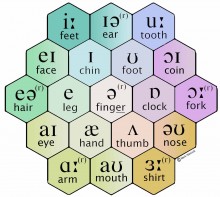Mark's Vowel Sound Chart

Check out the full chart here. See a video here. I’ve been developing a new phonemic chart to use with my students. The part of it showing vowel sounds is hexagonal and tries to show the sounds as a system, with vowel length in concentric rings, and place of articulation in radiating spokes: The outer ring of hexagon cells contain the long vowels and diphthongs; The inner ring of hexagon cells contain the short vowels; The central hexagon cell contains the weak vowel sound known as schwa. An interactive version of this chart has been created by Mura Nava.
Notes:
1. Each long vowel occupies a corner of the chart.
2. In this system, the vowel sound in hair is treated as part of the system of long vowels, although its phonemic symbol shows it to be a diphthong.
3. The remaining cells of the outer ring are occupied by the diphthongs. These are vowel sounds where the mouth starts in one position and then changes to another. They are positioned on the chart according to the starting position, which is in the same place as one of the neighbouring vowel sounds.
4. Each short vowel sound on the inner ring of hexagons corresponds to the long vowel sound on the adjacent cell in the outer ring.
5. The central cell, containing the weak sound known as schwa, occupies the unique central position on the chart. Schwa is different from the other vowel sounds because it can only occupy an unstressed syllable.
6. The other vowels on the chart are distinguished from each other either in length or mouth position. Schwa is distinguished from all the others by being weak.
7. Some of the symbols include (r) . This represents the fact that these sounds are usually spelt with an R. This may or may not be pronounced, depending on the accent.
Let me know what you think of it!




Comments
Bill Acton
Wed, 07/01/2015 - 18:35
Permalink
"Hive model"
Mark Hancock
Wed, 07/01/2015 - 19:57
Permalink
Thanks Bill! Would pulling it
Phil Keegan
Thu, 08/01/2015 - 11:10
Permalink
Chart
Mark Hancock
Thu, 08/01/2015 - 13:30
Permalink
Yes, Phil, consonants coming
John Whipple
Sat, 10/01/2015 - 18:15
Permalink
More DIY Phonemic Charts, Please!
John Whipple
Sat, 10/01/2015 - 18:25
Permalink
More DIY Phonemic Charts, Please!
Petr
Sat, 10/01/2015 - 19:38
Permalink
thumb
Mark Hancock
Sun, 11/01/2015 - 15:32
Permalink
Thanks, John - coming soon!
Mark Hancock
Sun, 11/01/2015 - 15:32
Permalink
Thanks Petr - I'll check it
Mark Hancock
Sun, 11/01/2015 - 19:17
Permalink
Ok, looks like Mura Nava has
Petr
Mon, 12/01/2015 - 20:32
Permalink
Thanks!
Laura B
Tue, 27/01/2015 - 18:28
Permalink
schwa
Mark Hancock
Wed, 28/01/2015 - 10:12
Permalink
'r'
Add new comment